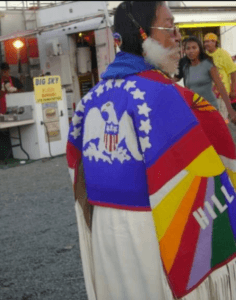More than 3,000 participants attend Minneapolis event
Presidential Indian Peace Flag needs historical preservation

Ernestine Gopher beadced emblem of Indian Peace Flag and the memory of Hill 57 onto her buckskin dress.
By Glenda Eagleman for Buffalo’s Fire
Determining the future of an historical, 13-star Presidential Indian Peace Flag hasn’t been an easy task for an Ojibway family. Many have been involved including, judges, band members, family members, attorneys, journalists, other Ojibway nations, elders, artists, military men, politicians, ceremonial people, a nun named Sister Providencia, a man called Soldier Chief, writer, Frank B. Linderman, and the late granddaughter of Linderman, Sally Hattfield, and her husband Bob Hattfield.
Over the years, the flag has caused much controversy, heartache and division. However, oral history says the flag could’ve been handed down through the generations and might have originally been handed down to the original descendants of Loud Thunder, who was given the title of “The Fourth Guardian.” The flag could have originated from the Great Lakes area. It might have a history earlier than that, according to oral history from today’s Ojibway elders, who are descendants of landless Ojibway.
Often times, some Ojibway band members round dance every October in Great Falls, Mont. And more importantly, some of the Ojibway elderly men can be seen dancing the night away with smiles and laughter on their faces and song in their hearts.
One Ojibway elder, Mike Gopher, grandson of The Fourth Guardian, or Loud Thunder, has researched the ancient flag’s history extensively. He recently said, “one step back for our ancestors and one step forward for our future generations,” meaning he would like to remember the ancestors but move forward for the future generations, when it comes to over-coming controversy for the historical flag.
I can almost picture the hardship the band members’ ancestors faced — my ancestors– as they made their way westward, carrying the 13-star flag. It’s a Presidential Indian Peace Flag and could be the only existing flag of some 40 flags hand-sewn centuries ago, possibly between the late 1700s to the early 1800s. In addition, according to the Smithsonian in Wash. D.C., they theorized it could possibly be the oldest flag in existence today.
I speculate, how in those days, they must have travelled over rough terrain, through starvation, harsh weather, and many tears.
Today, Ernestine Gopher, Ojibway elder, wears a traditional buckskin dress when she dances at powwows throughout Indian Country. “The beadwork on my hand sewn traditional buckskin dress tells a story,” she says, “the colors and design tell a story of the tears of my people.”
The colors are vibrant and beautiful on her dress. And it’s plain to see in her beadwork, the Presidential 13-star flag hand-sewn on the back of her dress, the flag has an eagle with the breastplate of George Washington’s seal. The beadwork shows meticulous patterns of red, blue, yellow and white. The beadwork tells a story of how strong the Ojibway band must have been and still are today, as landless people with a rich culture that still survives.
Later, in our conversation, I glanced at my aunt’s now aging hands and thought how it must have been painful for her to bead for months and months. I could hear laughter and singing and dancing off in the distance, as we spoke of her people. As we visited at a powwow, I could smell fry bread and traditional food being cooked, and it felt like home.
A judge in Great Falls, Mont., recently issued a court order to create a board of trustees to oversee handling of the13-star flag. The board of trustees are now safeguarding the 13-star flag, in Great Falls, Mont., however, it has not been properly preserved yet nor is it kept in a museum.
The landless Ojibway Band still make their home on the outskirts of Great Falls, Mont. The flag is centuries old and it should be preserved, protected and enjoyed for future generations of all people.
It’s a decision that elders must make, along with professionals, because more than likely, the ancient flag could be facing deterioration without proper protection and preservation. It should be done with honor and respect for the landless Ojibway band and the elders. The flag, like Gopher’s beaded buckskin dress represents the tears of my people.
And one of Gopher’s wishes is that she hopes to donate her traditional dress to a museum alongside the flag. Where does this 13-star flag end up and what kinds of solutions can people decide on, if any? Especially, when it comes to such an important relic, as the ancient 13-star flag.
Jerry Boland, one of the board of trustees says, “the flag is being kept in a safe and secure place.” He is also interested in preserving the flag’s history. The board of trustees who oversee decisions and handling of the 13-star flag had a meeting scheduled on Aug. 2 at the Cascade County Courthouse, Great Falls, Mont.
Glenda Eagleman completed the American Indian Journalism Institute program at the University of South Dakota, which was then-funded by the Freedom Forum.
External
This article was produced for ProPublica’s Local Reporting Network in partnership with Honolulu Civil Beat
ProPublica
Inspired by her grandparents, Tonah Fishinghawk-Chavez proves that caring for the community is an action, not just a word
Police and family looking for Angel Mendez and Zayne LaFountain






